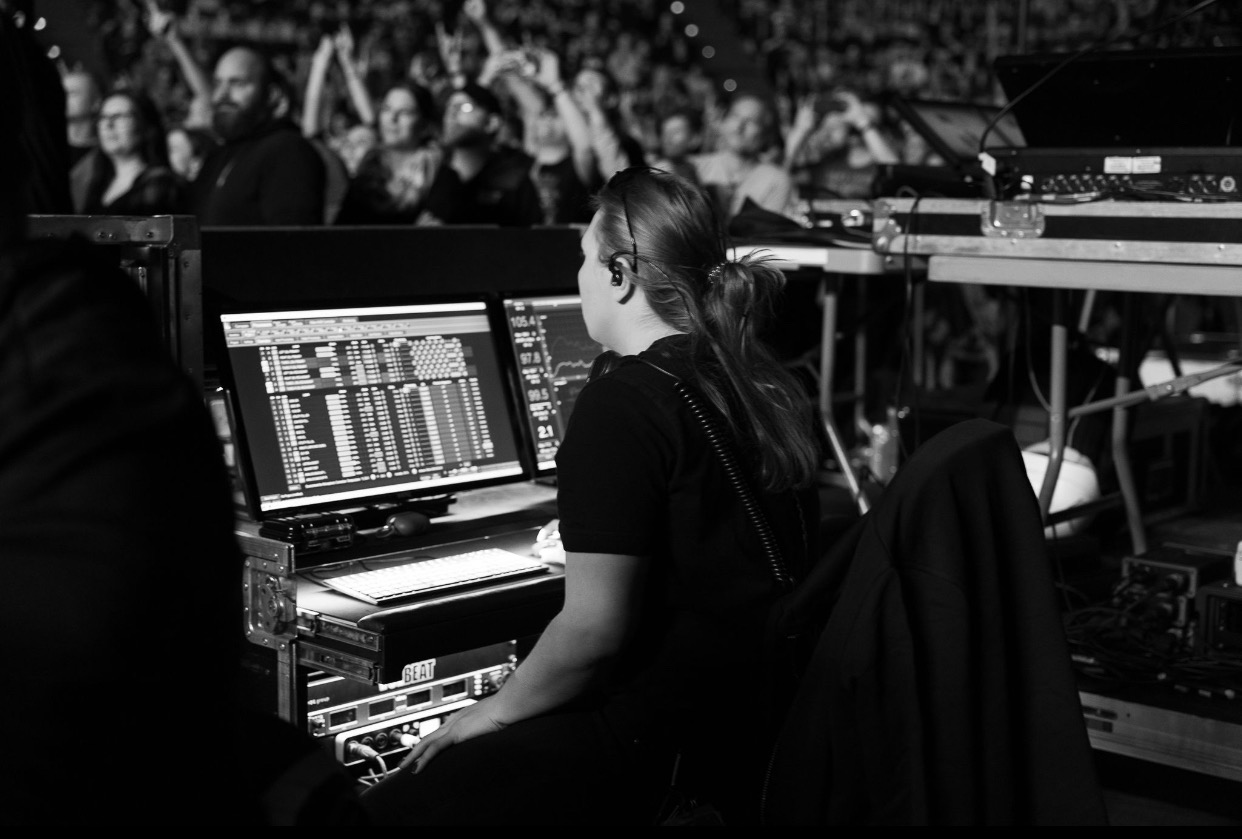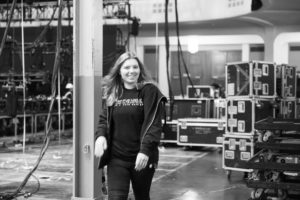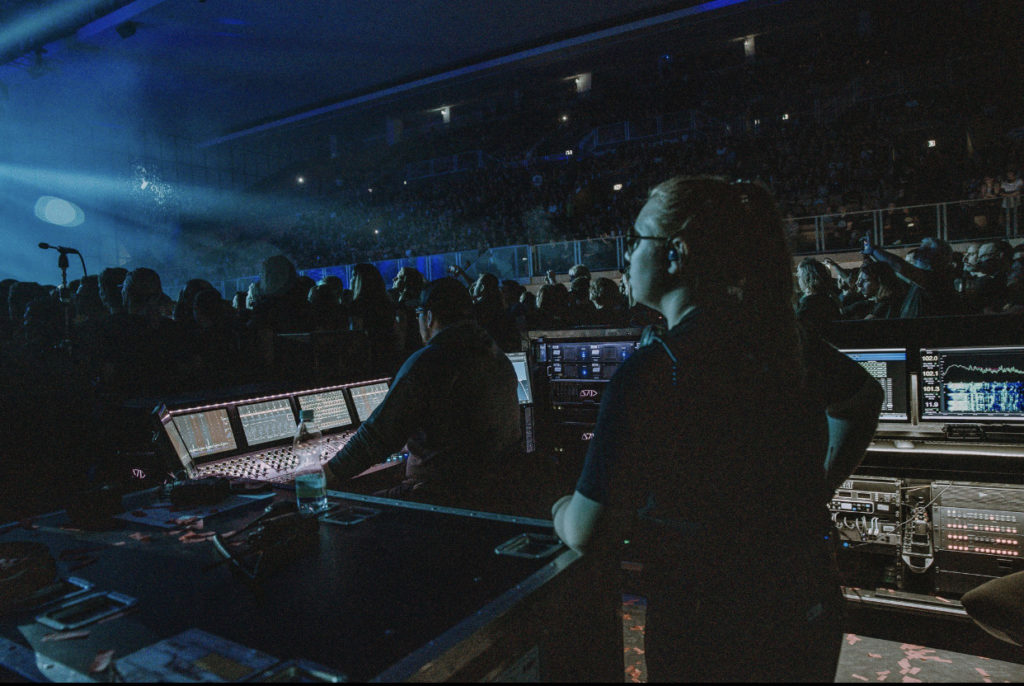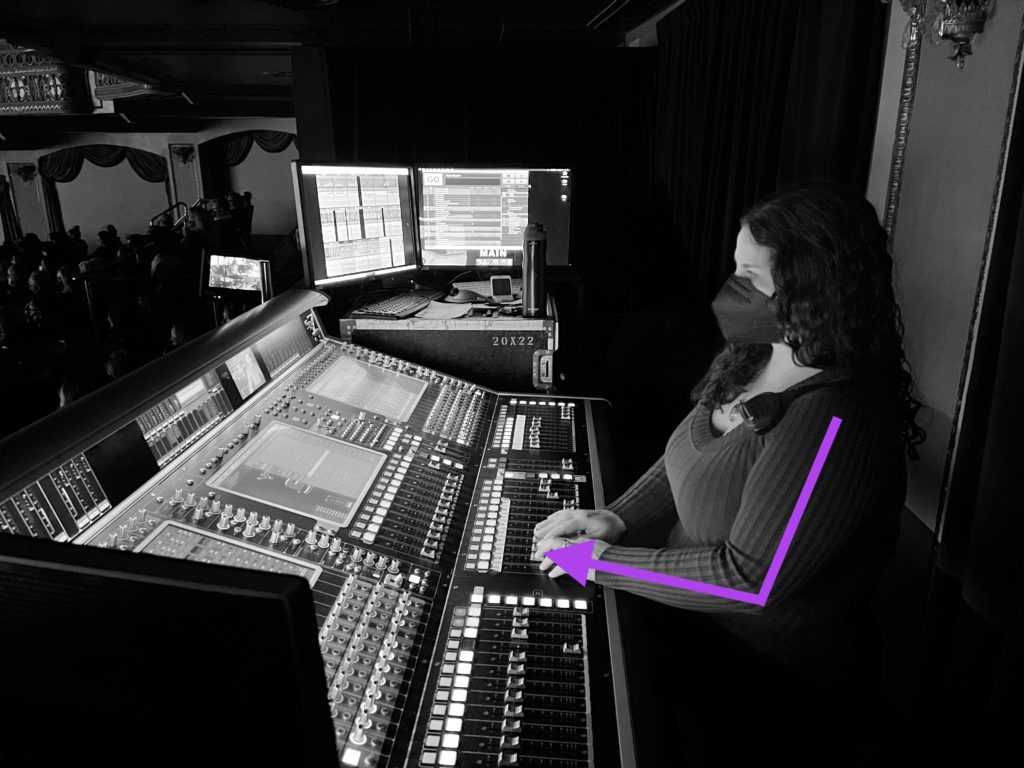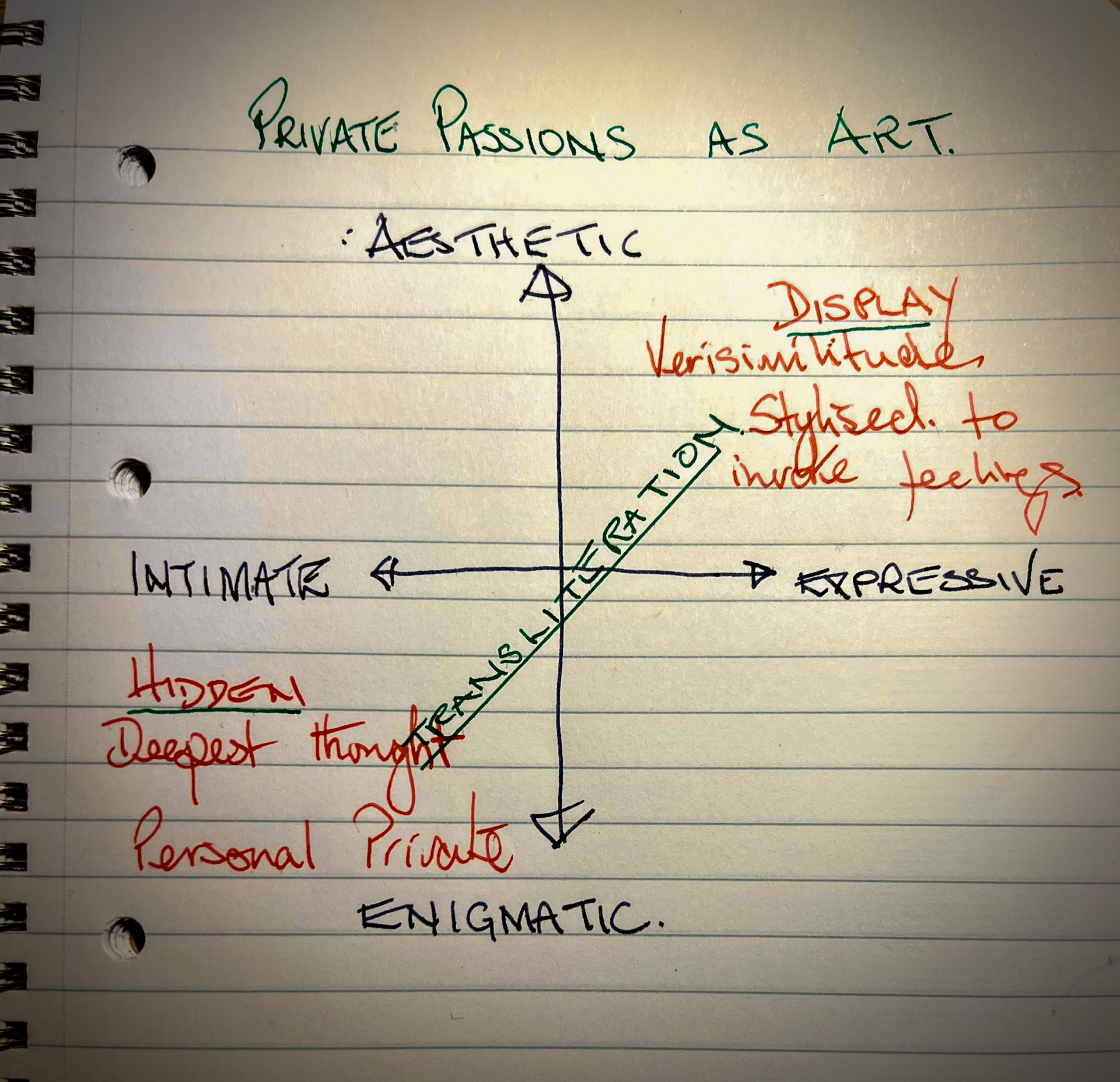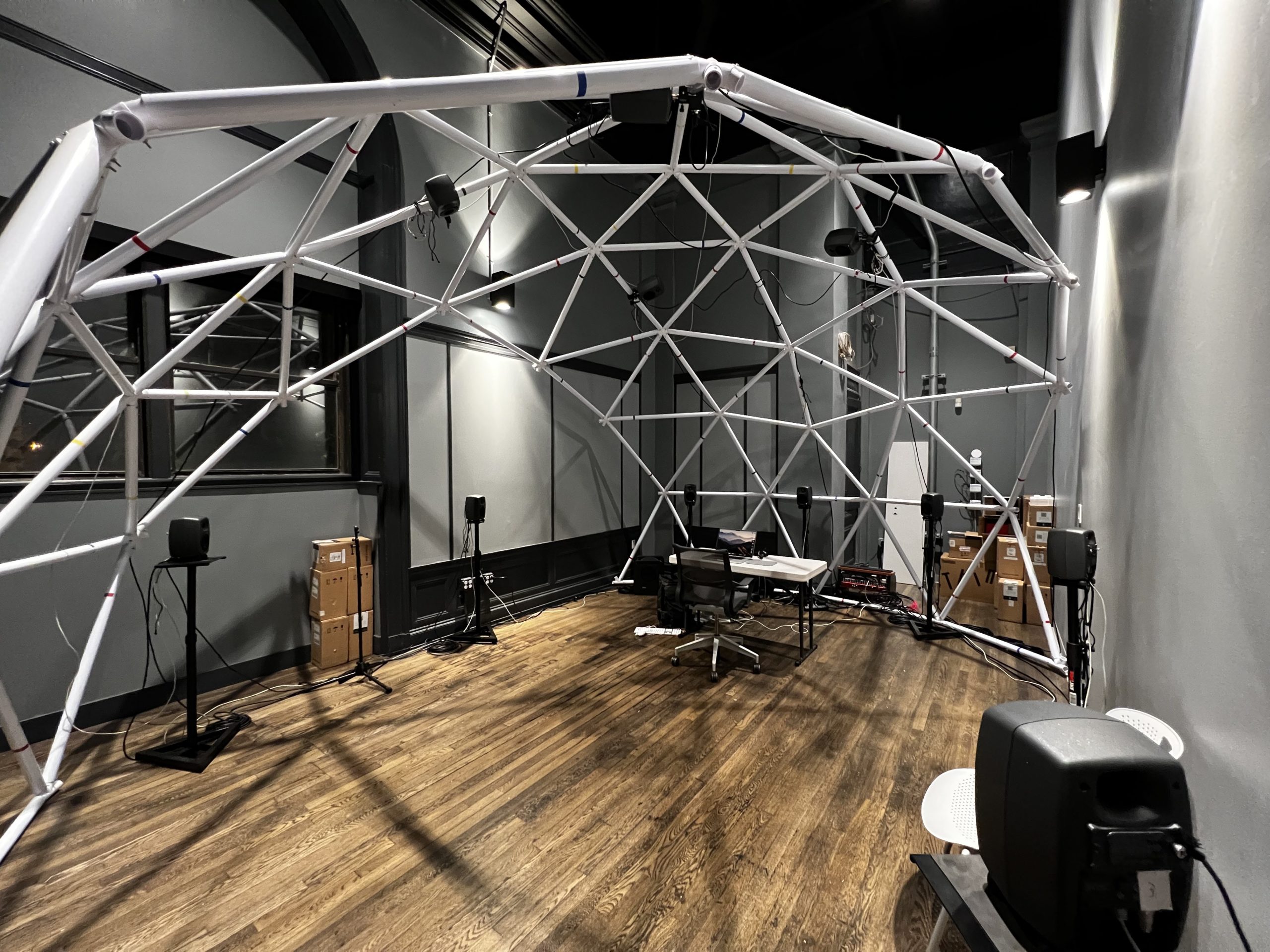
Woman is not defined in relation to man. On this understanding is founded our struggle for freedom.
Carla Lonzi. Rivolta Femminile – Rome 1970
I hope you will forgive my overtly political opening, but we are SoundGirls and have the luxury of being able to stand up for our rights in this patriarchal society without the constant fear of being beaten, arrested, and killed even. The story is very different in other parts of the world, and I don’t want to forget the bravery of Iranian women at this time.
As this is the last of the current series of blogs, it would seem a fairly obvious step to review my year of anything and everything. As an activist for human rights, which sounds grand but in reality is a series of small gestures for the oppressed which for me, means: women’s rights, the LGBTQIA+ community, and, most pressingly at the moment, freedom and self-determination for the women of Iran. I know that there are men alongside the women in Iran but symbolically this is a woman’s struggle:
And because women bring their radicalism to the uprising, it can be said that a government can still hope to get away with it when only men are in the streets, but when women come out en masse, that government is finished.
Rossana Rossanda, from Le altre, Manifestolibri 2021
The reason Iran is important to me is that the women of Iran have already given so much in the struggle that they must win. Their bravery is nothing short of inspirational, and of course, we know that this is important for all the women of this world. Iran is not about hair, though haircutting is a beautiful symbol of the struggle. In the final analysis, it’s about one struggle… to achieve one goal: the freedom of self-determination for every woman and gender-fluid person, to be free and equal in, what is at present, a man’s world: Liberty is the pathway to Equality.
As an active feminist and member of the LGBTQIA+ community, these things that are generally seen as outside of the arts are for me fundamental and are expressed through art. Art that subverts and is often revolutionary; art that represents the struggle and oftentimes becomes a rallying cry or a hymn, seems to be alive and well in Latin America. By focusing on protest and revolutionary music of Latin America, reminds me that very early on in this cycle of blogs, I championed the virtues of authenticity in art. I don’t have an authoritative definition of what constitutes authenticity in art, but I imagine that it has something to do with the reasons for which it was created and why it exists in an artist’s oeuvre. Music that is commercial can obviously fit into this paradigm of authenticity: Taylor Swift’s “Folklore” seems a good candidate in this respect. An example by the Argentinian rapper, Ana Tijoux and Los Chikoz del Maiz found a place in my life today with their protest song and video, the moving images an important part of the song’s message.
This is the song that started me thinking about migration and racism: The Strange Journey by Ana Tijoux and Los Chikoz del Maiz https://youtu.be/3O9PWUvd3y8
Italy now has a fascist government which after a short while in office, is falling into line with its ideology of racism: Italy for the Italians, etc. There has been a standoff between Italy and the rest of Europe over refugees being banned from entry and kept at sea in insanitary conditions. This is from this morning’s newspaper “La Stampa”:
The headline, “Italy Inhumane” and the byline, “Italy has been most inhumane and its authorities unprofessional in the face of the emergency”
The Bar chart on the right shows the actual numbers of migrants accepted; the last three, Italy, Hungary, and Poland all have far-right governments.

I’ll come back to the question of authenticity in a short while after I recap the timeline that has brought me to this delicious but scary point in my life. I graduated from the University of East Anglia in 1978 having studied Music and Fine Arts – about 80/20 %. My specialisms turned out to be – because you never know, they just happen sometimes – Early music and Contemporary music, I have since filled in the missing classical and romantic periods.
In my first blog, I tried to establish a link from my experiences of electroacoustic music of the late seventies to the present, which has taken me a while of experimenting with the sonic possibilities of newer technologies. So, after a year of experimenting with processing my recorded sounds, having learned to make use of synthesized sounds through the MAX MSP modules and adapting sound samples from the Spitfire Audio library, I still mainly use my own recorded samples. On a technical note, I use the Zoom H6 Handy recorder and I usually record at 96 kHz 24-bit; 32-bit floating point is not available on this recorder. Though, as I have said in a previous blog, I also record on my iPhone since it is always with me. Now I remember talking about ‘dirty recordings’, background noise, wind noise, accidental knocks, etc. I can honestly say that I treasure my dirty recordings which are processed in Adobe Audition as 96kHz 32-bit wav stereo files; moreover, they remain ‘authentic’ since they represent a time. a place and a sound experience; they are original and individual, and the sound would not exist without the sound artist’s intervention in rescuing it and preserving its memory – thank God (though I am an atheist) for my iPhone. The two links below demonstrate Zoom’s IQ6 and IQ7 microphones for iPhone or iPad; maybe worth carrying the IQ7 which has some interesting features and captures stereo via its specific software app.
https://www.youtube.com/watch?v=–FVSsSTTeM&t=15s
https://www.youtube.com/watch?v=ikWgl2eLwqk
In February, I considered the term ‘Experimental music’ and came across these definitions which hold some truth and possibility:
Experimentalism is entirely separate from any musical form and focuses on discovery and playfulness without an underlying intention.
In other words: Experimental compositional practice is defined broadly by exploratory sensibilities radically opposed to, and questioning, institutionalized compositional, performing, and aesthetic conventions in music.
If I’m honest, I start off with an underlying intention, but the experimentation and failures, and adapting means that the underlying intention for me is much more fluid. Experimenting is a key element in sound art, including my own works. I suppose that what I do with my recorded samples satisfies most of the criteria cited. However, in my most recent piece, Debris of a Night, I used feedback recorded with my Zoom H6 patched through my interface and recorded onto Reaper, fig 1. I recorded three tracks, and I got better at controlling the feedback with each take though the chance element was high which gives it its ‘chance’ credentials. When I recorded the vocal track, I played track 3 at the same time so that I got a noisier version of the feedback alongside my vocal, and then, at the creation and mixing stage, I put both tracks slightly out of sync for an echo effect which is not always noticeable but drifts in and out as other sounds in the mix either mask or reveal. Tracks in Audition during composition and mix are shown fig 2. My evolution as a Sound Artist, though this is not the whole story, has been one of getting away from a classically inspired approach on which the narrative thread of each piece gives me a framework on which to hang my vision. I can exemplify what I mean.
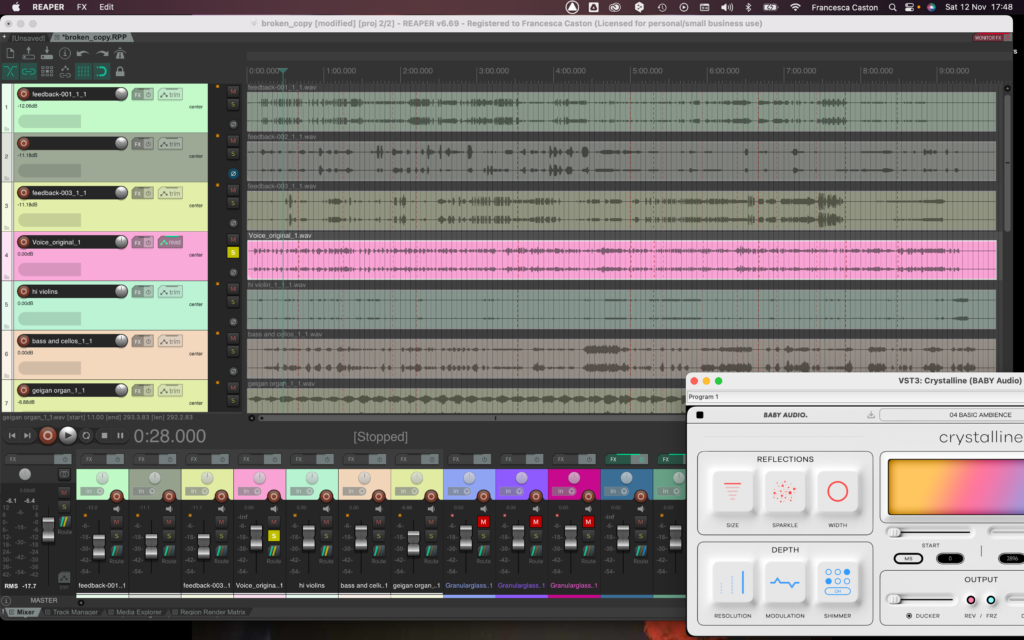
fig 1
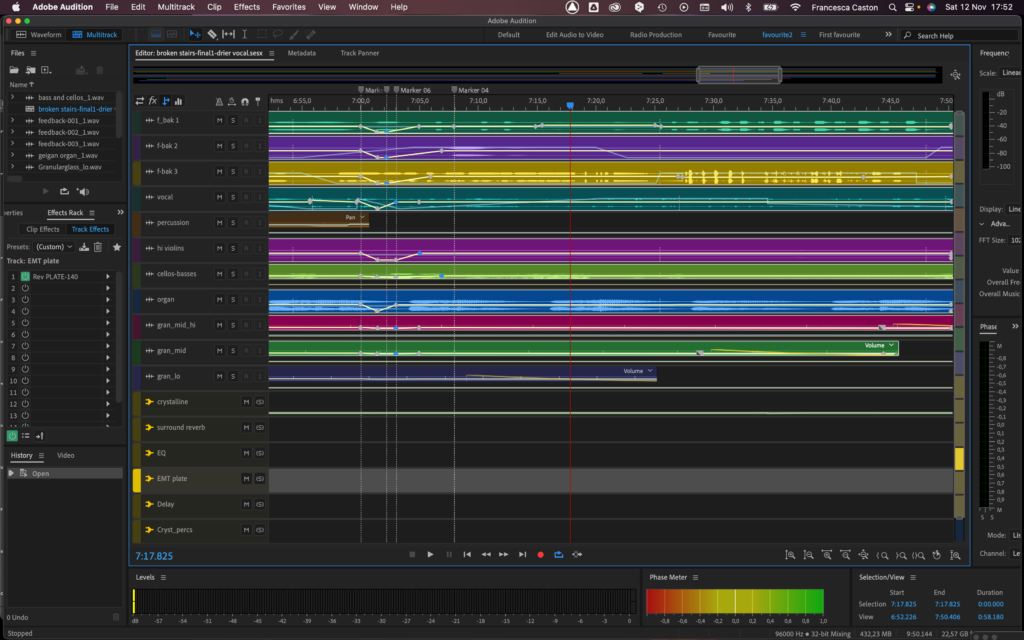
fig 2
Looking at the works I created this year, Her Blacks Crackle and Drag, based on a work I built around the poet Sylvia Plath (another dream) is almost symphonic in its proportions which is probably due to the narrative structure that underlies it and my still classical ethos. So, in five movements, lasting 24 minutes, the piece had 63 tracks and two buses and used 98 separate sound files.
My next piece, Bamboo: the foolishness of things is shorter at 15 minutes but still made use of 32 tracks and two buses. Although it was based on a short piece of text from The Book of Tea it is less noticeably a story but inhabits a more self-contained sound world. This can be found at the link below.
https://soundcloud.com/francesca-caston/bamboo-the-foolishness-of-things
Debris of a Night, as I have already suggested, was mainly improvised in the sense that the vocal track was improvised in terms of content and timing, by which I mean that I recorded the words to fit into the spaces and general feel of the three feedback tracks. Not only were these four tracks improvised but so also were the instruments; after some rehearsal, they were recorded along with the voice and feedback. The percussion track was added last, a midi file in Reaper was improvised alongside the vocal and then exported back to audition for the final balancing mix. This was not any easier technically but was only 11 tracks plus 6 buses since each track can only be sent to one bus in Audition. This piece has taken me closer to how Sound Art and Electroacoustic music have changed over the years and is also a transitionary step towards working with live electronics and performing musicians.
For this piece, I made use of the new algorithmic reverb plugin from Baby Audio, Crystalline. It came about since I got some feedback from CMMAS which suggested that I had overdone the reverb (EMT Rev Plate – 140), I had originally added delay to confuse the text, already struggling amongst the feedback tracks and the idea was that I would automate its gradual fade out so that the voice became clearer, bearing in mind that it was recorded, handheld within the feedback sounds so was already uneven.
At this point I have to explain my personal ethic as a sound artist, and here I invoke yet again the concept of authenticity. This piece is based on a recurring dream I’ve had for years which is probably telling me that I have an anxious attachment style and a fear of abandonment dating back to my childhood, but I know this anyway. So, whilst not trying to create an aural equivalence of the dream, the sounds, and the music suggested confusion at the opening and the heavily processed voice of the original was me, gradually coming out of the oppression of the dream and gaining control over the situation. However, also recognizing that it is a piece of art that wishes to communicate something, I also have to be aware of my potential audience and the need to create an aesthetic around my means of expression. In other words, my deepest, most personal, and intimate thoughts and feelings are presented as a thing of beauty, poetry, and metaphor, ready to elicit analogous sensations in those who witness the performance. In other words, I feel a duty to be clear.
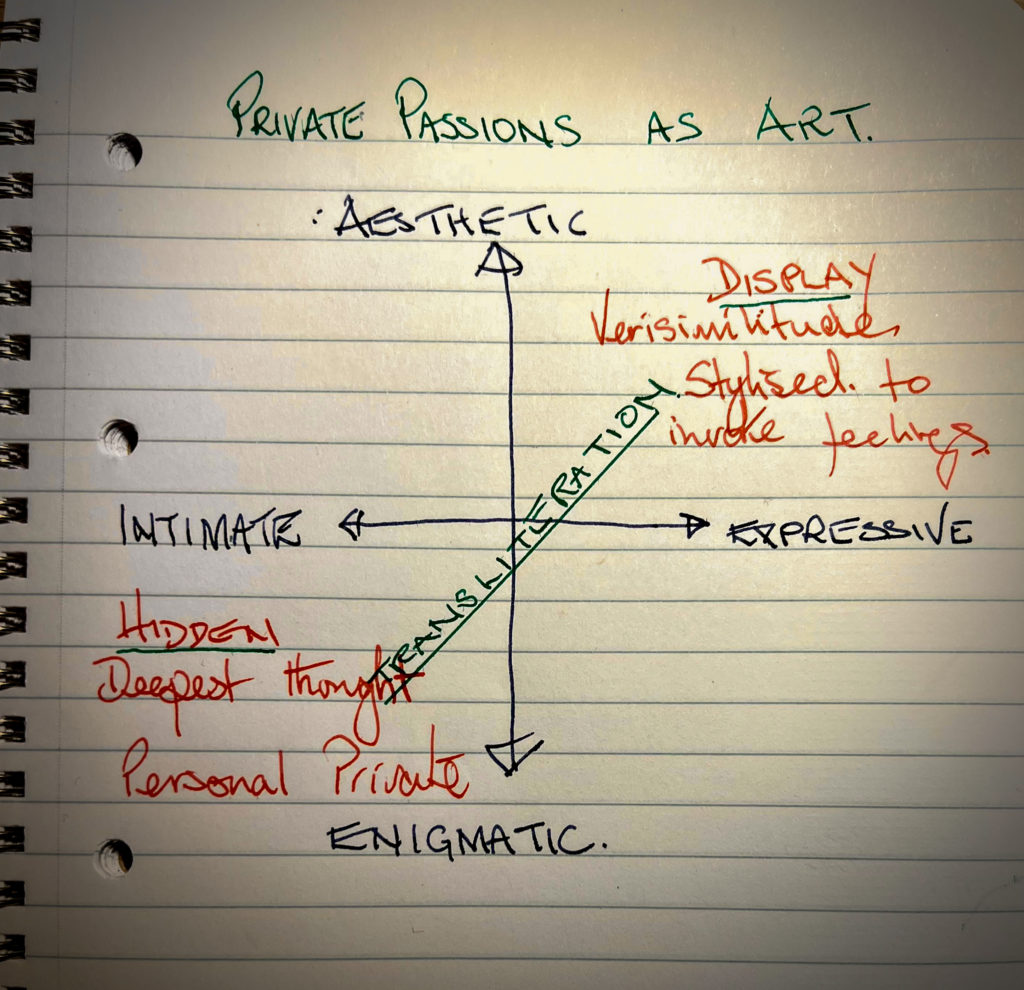
While trying to work out a way in which I can represent personal feelings through art but in a way that might be comprehensible to an audience, I sketched out a few ideas in which my metaphorical somnambulism might be represented in a way that does not expose my innermost feelings and yet is interesting enough for an audience to want to listen and try to understand. Through an analogous process of transliteration, I reinterpret what is hidden within me into a thing of beauty that is ready to be understood. I use the word beauty in the aesthetic sense.
Taking account of these considerations, I took on the technical challenge of wanting reverb on the voice to establish being lost in a wilderness of emptiness and yet also in an edifice that is both physical and an analogue of my mental state. In the end, I decided to opt for Baby Audio’s algorithmic reverb unit which seemed to have a clean sound and a very user-friendly interface where the fine-tuning controls are presented as realities rather than just numbers; as an experimental composer, I find that twiddling and listening carefully is more natural to me than relying on visual numbers – notwithstanding the usefulness of numbers if I want to find a setting I like.
Now it’s clear to me that reverb can easily get lost among three tracks of feedback and so I listened to the vocal track soloed and also in the company of various other tracks and, as I’m sure you know, what sounds a bit too much solo, can be just right in the mix, and this has been another part of my development after my 40-year absence from electroacoustic music: the bus tracks! I won’t go into the differences between bussing in Reaper or Audition, just enough to say that I still find Audition clearer for me to work with. The following sound samples are based on a fragment of the solo percussion track, which was improvised live to complement the voice, though I had to do a small amount of splicing for precise entries. I’m using the percussion track rather than the voice to exemplify the reverb options I considered since it is easier to distinguish the various phases of dry attack and wet reverb. You can see from the waveforms how the various reverb units have affected the sound. The Soundcloud link takes you to the sound samples: 1: dry; 2: Audition Surround reverb; 3: Arturia EMT Plate – 140, and 4: Baby Audio – Crystalline.
https://soundcloud.com/francesca-caston/reverb-on-percussion
or if you cannot get access since the link is private the following link will work
https://soundcloud.com/francesca-caston/reverb-on-percussion/s-FskkBr2KGv6?si=e3bc23fb003f405fbc611844c90b6ce4&utm_source=clipboard&utm_medium=text&utm_campaign=social_sharing
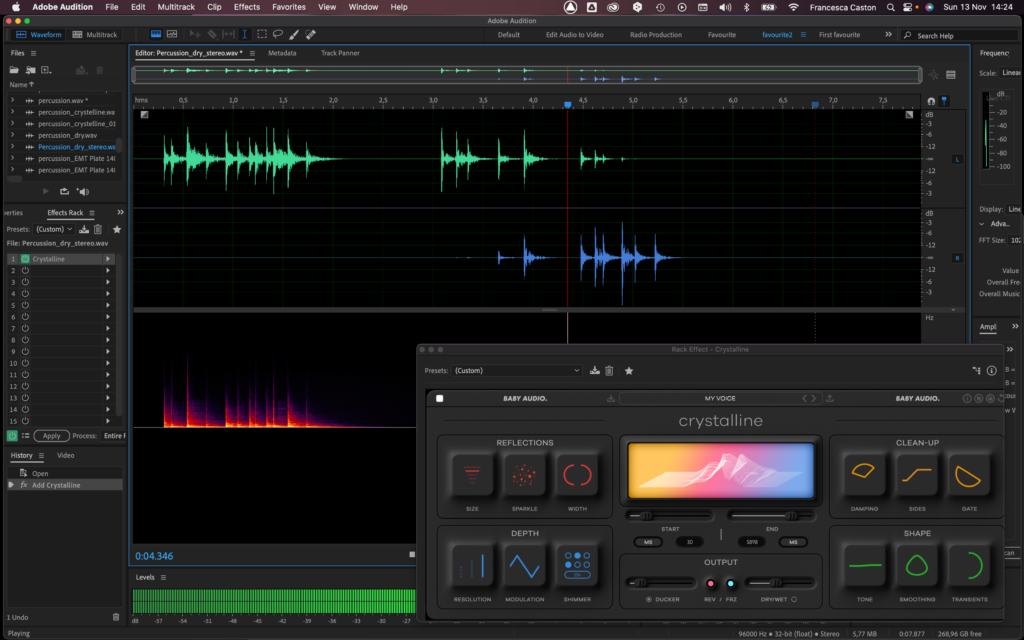
The link below takes you to a full explanation of the controls of the reverb unit, so I shan’t overelaborate. In this example, I used a preset that I created ‘my voice,’ which sounds better on the solo track than the percussion preset. However, in the mix, I used the ‘percussion’ preset given that it was competing with three tracks of noisy and unpredictable feedback. This preset highlighted the transients a bit more: shape/transients placed the emphasis on the attack and the clean-up/damping controls highlighted the upper partials by adjusting the low pass filter. This is the beauty of this plug-in for me, the icons on the controls change shape to represent visually what is being shaped. The left side controls change the nature of the reverb and mimic the size of the space. The BABY AUDIO button at the top is a by-pass and the center panel has the familiar dry/wet control and a ducker (see the video for an explanation of the latter – I didn’t use it). The controls I found really useful were the start/end allowing me to delay the onset of the reverb for a dry start, giving a cleaner attack and the end control allowed me to adjust the length of the reverb. I had a great time experimenting with these and felt that I could really shape my sounds. Despite my antipathy for too many numbers, these settings, expressed in milliseconds, were useful, especially if I wanted to repeat a certain setting. So, in summary, a user-friendly interface made controlling the reverb relatively easy. If you are interested to know more the video (linked below) is a good introduction. And of course, the sound is good, although the reverb component can be heard differently according to the nature of the input. In these examples, the reverb changes from the first burst to the second in respect of the different instruments.
https://youtu.be/FquRvVSInZc
To hear the percussion within the piece Debris of a Night go to just after 5 minutes:
https://soundcloud.com/francesca-caston/debris-of-a-night
At this point, in my artistic development, I am looking forward to my move to Mexico with the main aim of working collaboratively with other artists at the Centro Mexicano para la Música y las Artes Sonoras (CMMAS) in Morelia, Michoacán, México which is just a four-hour train ride from México City where there is a strong presence of Sound girls.org and I have already contacted one of the Sound girls in Mexico City and look forward to getting to know them. There is also a thriving arts scene there. Mabe Fratti, a young Guatemalan cellist, vocalist, and experimental composer is in that ‘sweet spot’ between experimental musician and contemporary performer. She has the voice of an angel but can shred through her pedal board and electronics. Here she is with Concepción Huerta in live performance and live electronics in a very homely setting. Oh, and I forgot to mention the way they look at each other at the end; real collaboration and a ‘did we do OK?’’ maybe.
https://youtu.be/2hqgSxJsdKI
I thought it might be OK to mention two Latin American Sound Artists with whom I hope to collaborate. Rodrigo Sigal is the director of CMMAS and, as I discovered after reading his paper on the state of electroacoustic music in Latin America, did his Ph.D. with the same professor with whom I had studied in the late seventies. So apart from the coincidence itself, there might be some similarity in our approaches to sound art since our shared teacher had studied in Paris with members of the French School: Pierre Schaeffer, Pierre Henry, and Bernard Parmegiani, among others; composers who spearheaded the musique concrète movement. The center has a wealth of talent and materials to share including courses on Tidal Cycles; Super Collider; MAX MSP, as well as hybrid practices ranging from orchestral and instrumental to fully electronic music production. This piece by Rodrigo, Frictions of things in other places, is typical of a style that inhabits a ‘sound world’ and moves the sound around in a dynamic way.
https://youtu.be/Uyx43HjuzKA
Ana Maria Romano Gomez is a composer I met online through the Oslo-based arts and technology group at NOTAM. She is based in Bogotá, Columbia, and has almost single-handedly organized and represented a woman’s movement in contemporary music. I was delighted to discover that she is preparing a course for the center in Morelia and again, we both have a good deal in common from the fact that we are both active feminists to our creative spirit even though we are from different continents. We have been in touch, and I hope that we will find opportunities to collaborate. Her introduction to the audio-visual work created for the Sound Perspectives 2022 at CMMAS states that:
“Ana María Romano Gomez is a Colombian interdisciplinary composer and sound artist, and her creativity questions the intersection between gender, sexualities, sound, and technology, and is traversed by listening, soundscape, space, body, and political dimensions in its creation. In all aspects of her life, she considers collective and collaborative work fundamental. Her works have been presented and published in Latin America, North America, Europe, and Asia. She has been an artist in residence at the Centro Mexicano para la Música y las Artes Sonoras (CMMAS). In 2019 she was nominated for the Classical Next Award Innovation for the management of the En Tiempo Real Festival in bringing to prominence the work of women artists: I think I followed much of that online.
She has developed in-depth research on the composer Jacqueline Nova, a pioneer of electroacoustic music in Colombia. She currently teaches at the Universidad El Bosque, coordinates the Plataforma Feminista En Tiempo Real, and is a member of the network of Compositoras Latinoamericanas “
In her introduction to the pieces, she suggests listening with headphones.
https://youtu.be/TtBaOe8cIkE
So, I’m counting the days to be in México. My plan is to be in Cuidad de México on 8 March, International women’s day, and then begin thinking as a Méxican sound artist, by which I mean, I will draw my inspiration from the vibe that surrounds me and collaborate with other artists on all kinds of projects: Song Cycle for soprano, rapper, harp, bass clarinet, and live electronics is on my list as well as working with a choreographer, and of course, meet some of the indigenous people, the Purépecha and maybe be inspired by their music.
But in reality, who knows what future awaits me? I’ll begin by just taking in the air of Michoacán, known as the soul of México, and absorb the musical vibe, and who knows… two quotes from Mexican singer, Natalia LaFourcade which I like. Speaking of a song collection and video she says: Un canto por México es una voz colectiva… and naturally I would like to be part of that voice. She also says: viva el trabajo en comunidad… well that just reminds me of one of the main reasons I want to be there.
And, if you like, you can see exactly what she means. These musicians are a collective voice, they are working as a team but, most importantly, having a whale of a time and making great music.
https://youtu.be/emTLbk7jd8E
So: con tanto amore e sorellanza a tuttə le mie sorelle Soundgirls,
baci
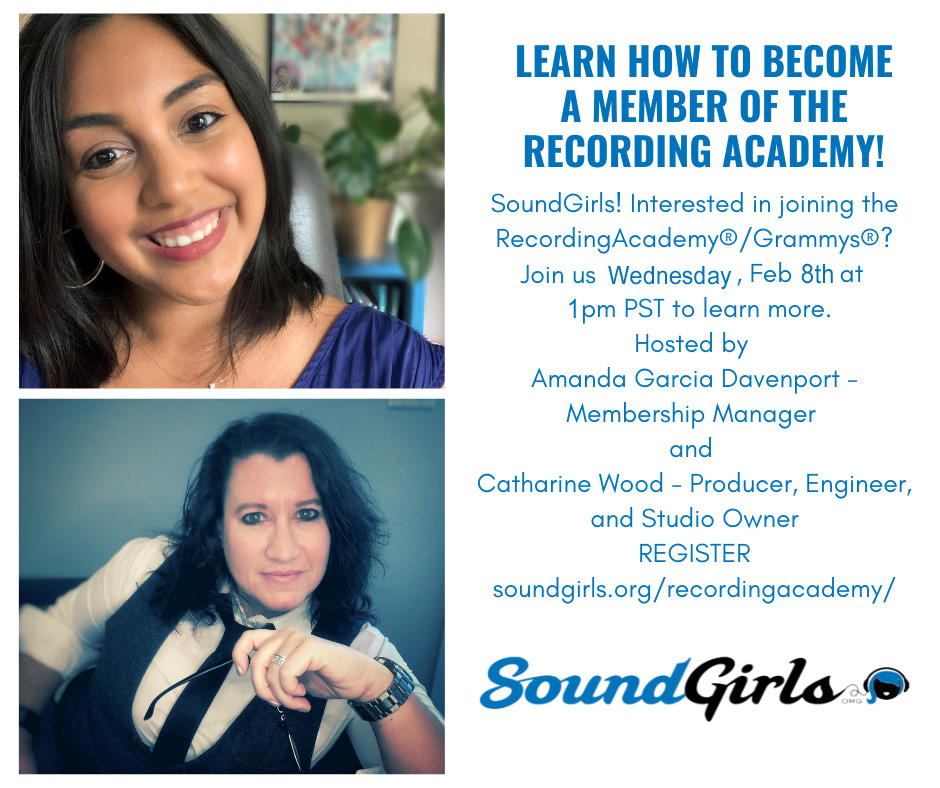












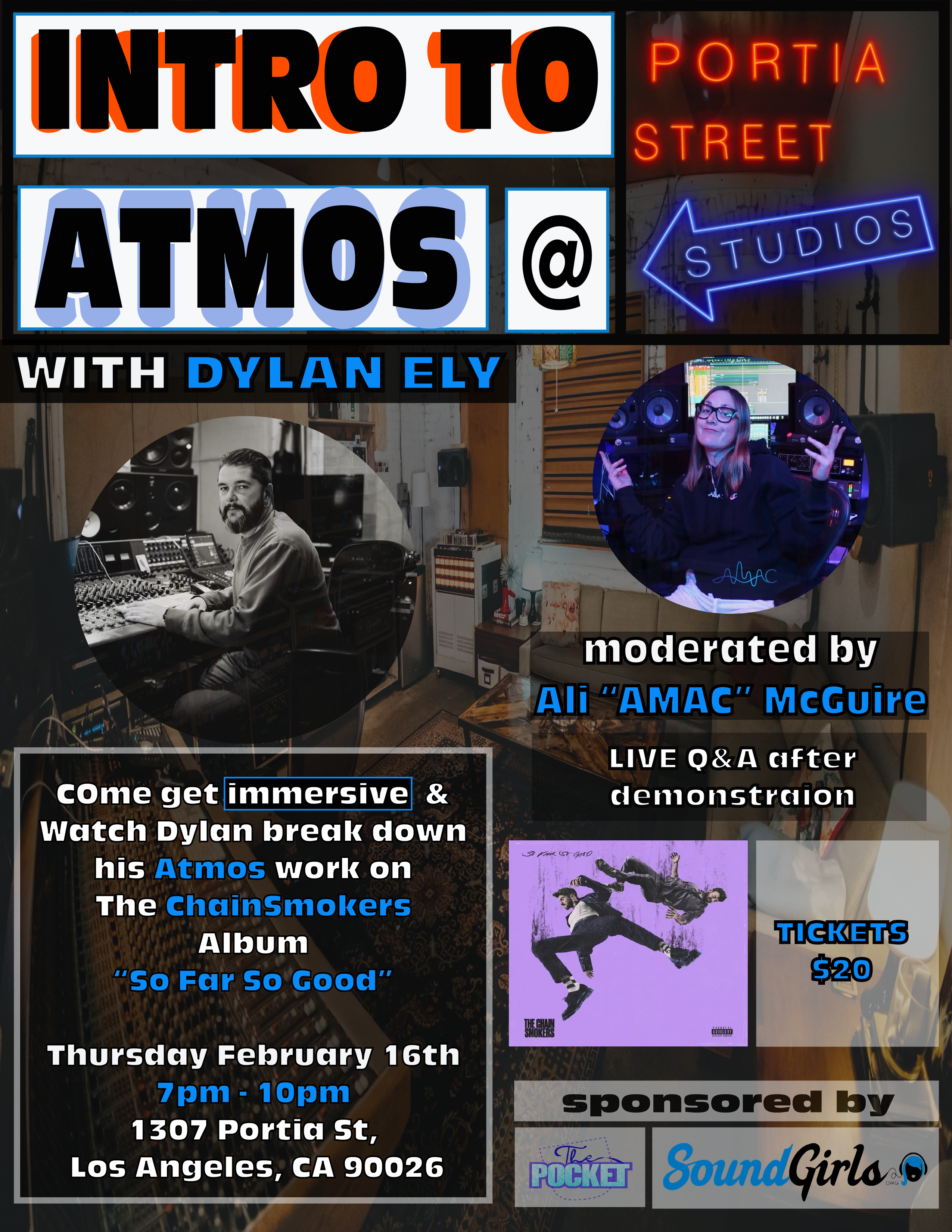
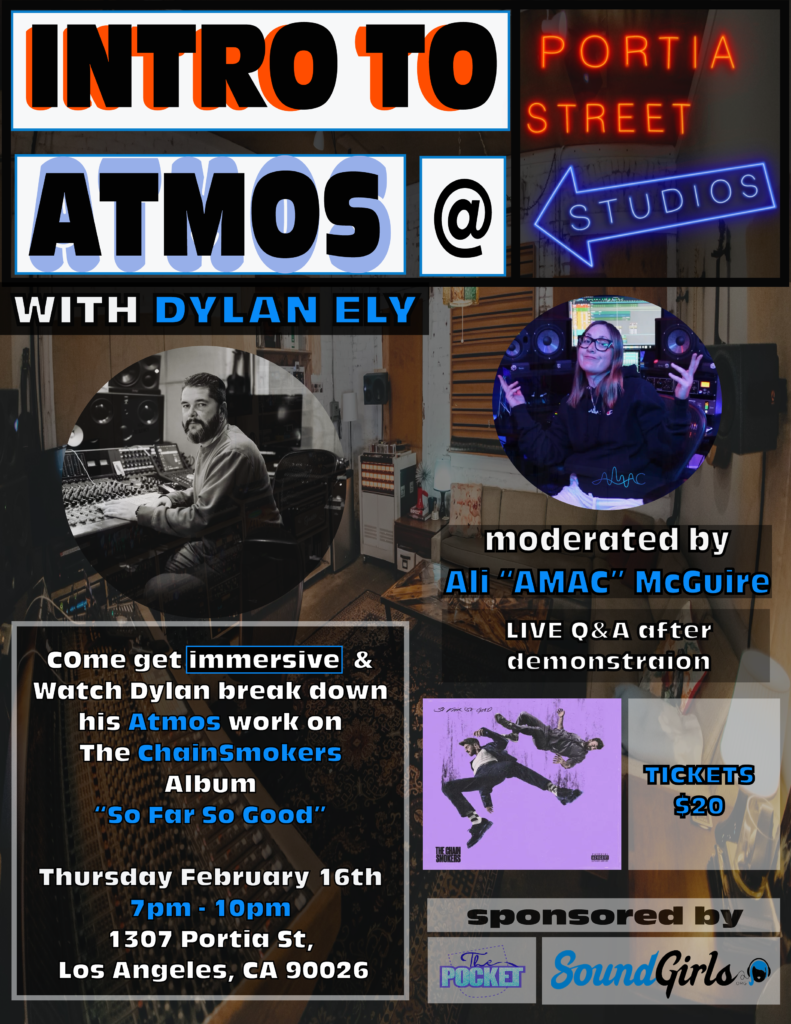 Register Here
Register Here